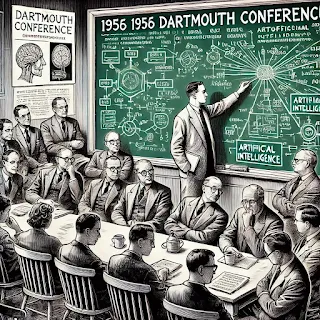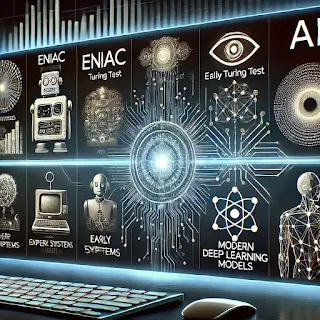The Evolution of AI: From Ancient Myths to 2025 Innovations
- Get link
- X
- Other Apps
The Evolution of AI: From Ancient Myths to 2025 Innovations
Introduction
Did you know that artificial intelligence (AI) has roots dating back to
ancient myths? From Greek legends of mechanical servants to modern-day
AI chatbots, humanity has long imagined machines with human-like
intelligence. But how did AI evolve from an abstract idea to today’s
cutting-edge technology?
In this article, we’ll explore:
✅ The history of AI—key
milestones from the 1950s to today
✅ The pioneers behind AI—from
Alan Turing to OpenAI
✅ How AI is created—the process
of training intelligent systems
✅ Future trends of AI in 2025 and
beyond
Let’s dive into this fascinating journey!
The Origins of AI: From Myth to
Science (Pre-1950s)
Before AI became a field of study, the idea of intelligent machines
existed in mythology and literature:
- Ancient Greece
(400 BCE): Myths of Talos, a giant bronze automaton that protected
Crete.
- 1495: Leonardo da
Vinci designed a humanoid robot powered by gears.
- 1818: Mary Shelley's
Frankenstein imagined artificial life, raising ethical concerns
still relevant today.
- Early 1900s: Sci-fi stories
like R.U.R. (1920) introduced the word "robot."
These ideas set the stage for real technological advancements.
The Birth of AI: 1950s – 1970s
The modern AI revolution began in the mid-20th century, driven by the
development of computers and formal logic.
Key Milestones
|
Year |
Event |
Description |
|
1950 |
Alan Turing's Test |
Turing proposed a
test to measure machine intelligence. |
|
1956 |
Dartmouth
Conference |
John McCarthy
coined the term "Artificial Intelligence", launching AI as
an academic field. |
|
1966 |
ELIZA chatbot |
The first chatbot,
ELIZA, simulated conversations using text-based responses. |
|
1969 |
Shakey the Robot |
The first mobile
robot to reason about its actions. |
AI Pioneers and Their Contributions
- Alan Turing
(1912–1954): Developed the Turing Test to evaluate AI capabilities.
- John McCarthy
(1927–2011): Created the term "Artificial Intelligence" and developed
LISP, an AI programming language.
- Herbert Simon
& Allen Newell: Built the first AI program, Logic
Theorist (1956).
Despite early excitement, AI faced setbacks due to computational
limits and lack of data.
 |
| The historic 1956 Dartmouth Conference where AI was officially born |
📍 Place Image 1
here
Image Title: The Birth of AI: 1956 Dartmouth Conference
Alt Text: A historic illustration of the 1956 Dartmouth Conference,
where AI was officially named.
The AI Winters: 1970s – 1990s
AI progress slowed due to:
🚫 Funding cuts
from governments and tech firms.
🚫 Computational
limitations—hardware wasn’t powerful enough.
🚫 Unrealistic
expectations—early AI was overhyped.
However, AI research continued, leading to neural networks and expert
systems in the 1980s.
The AI Renaissance: 2000s – Present
The 21st century marked an AI explosion, thanks to big data
and improved computing power.
Game-Changing AI Developments
|
Year |
Breakthrough |
Impact |
|
2011 |
IBM Watson |
Defeated humans in Jeopardy! |
|
2012 |
Deep Learning |
AlexNet
revolutionized image recognition. |
|
2016 |
AlphaGo |
Beat the world champion in Go, a
complex board game. |
|
2022 |
ChatGPT |
OpenAI’s ChatGPT-4
demonstrated human-like conversation skills. |
 |
| A timeline of AI's evolution from early computers to modern deep learning models |
How AI is Created: The Building Blocks
of Intelligence
AI development follows a structured pipeline:
1️⃣ Data Collection—AI learns from
massive datasets.
2️⃣ Algorithm Selection—Machine
learning models process data.
3️⃣ Training & Testing—AI
refines its accuracy.
4️⃣ Deployment & Monitoring—AI
systems continuously improve.
Popular AI techniques include:
✔ Machine Learning (ML)—Teaches
AI patterns from data.
✔ Neural Networks—Mimics the
human brain.
✔ Natural Language Processing (NLP)—Powers
chatbots and translations.
🚀 AI applications
now power voice assistants, medical diagnostics, and self-driving cars.
The Future of AI: Trends in 2025 and
Beyond
Emerging AI Trends
1️⃣ Explainable AI (XAI)—Ensuring
AI decisions are transparent.
2️⃣ AI-Powered Creativity—Generating
art, music, and writing.
3️⃣ Human-AI Collaboration—Enhancing
work efficiency rather than replacing jobs.
AI’s Potential Challenges
❌ Bias & Ethics—Ensuring
fairness in AI decisions.
❌ Regulations & Privacy—Balancing
innovation with responsible use.

How AI will shape the future, from autonomous vehicles to advanced robotics
Conclusion & Call to Action
AI has come a long way—from ancient myths to revolutionizing
industries. As we move into 2025 and beyond, AI will continue
shaping our world in ways we can’t yet fully imagine.
💡 What AI
breakthrough excites you the most? Drop a comment below!
📩 Subscribe to
AInexus for the latest AI insights!
References
- Turing, A. M.
(1950). Computing Machinery and Intelligence. Mind Journal
- McCarthy, J. et
al. (1955). A Proposal for the Dartmouth Summer Research Project on
Artificial Intelligence. Stanford University
- Weizenbaum, J. (1966). ELIZA – A Computer Program for the Study of Natural Language Communication. ACM Digital Library
- Get link
- X
- Other Apps




Comments
Post a Comment